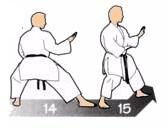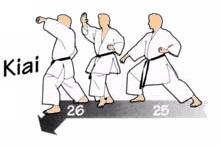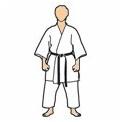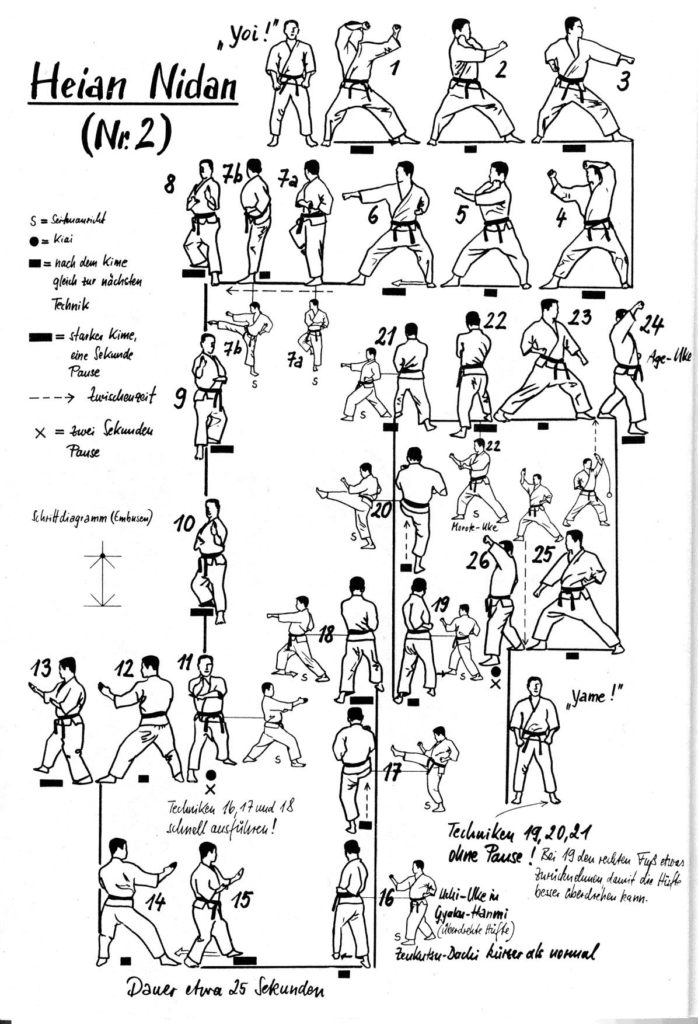Heian Nidan, the second Heian Kata, has 26 movements and the embusen is almost I-shaped.
This kata uses the same floor pattern as Taikyoku Shodan and Heian Shodan, but utilises a wider variety of techniques. Some of the new techniques include the front kick, side kick, brace block and spear hand. The complexity of Heian Nidan is much greater than the first two Katas taught in Shōtōkan Karate, and therefore hundreds of executions of the Kata are required before a student can become proficient.
HEIAN NIDAN
Peaceful Mind - second level
HEIAN NIDAN
Peaceful Mind - second level
Kata performed by Aragaki Misako
Some of the Key Moves:
- Kokutsu dachi (back stance)
- Shuto uke (knife hand block)
- Nukite (spear hand strike)
- Mae geri (front kick)
- Haiwan uke (double hand block)
- Uraken & Yoko geri keage (back fist & side snap kick)
- Gyaku hanmi (reverse hip in front stance)
The word Heian is a combination of Heiwan that means "Peacefulness" and Antei that means "Calmness." For this reason the meaning of the Kata signifies a "Peaceful Mind." The name suggests that the student who has mastered the five Heian forms can be confident in his ability to defend himself, and hence would be able to adopt a state of "Peaceful Mind." The original versions of the Katas were named Pinan and were created by Master Itosu in the early 1900’s. Master Funakoshi, during the creation of the Shōtōkan style, changed the names of the Katas for reasons he explains in his book Karate-Do Kyohan:
The names of the kata have come down to us by word of mouth. Names in use in the past included Pinan, Seishan, Naifanchi, Wanshu, Chinto, and the like, many of which had ambiguous meanings and have led to frequent mistakes in instruction. Since karate is a Japanese martial art, there is no apparent reason for retaining these unfamiliar and in some cases unclear names of Chinese origin simply because of earlier usage. I have therefore changed those names I considered to be unsuitable after considering the figurative nature of the old masters’ descriptions of the Kata and my own study of them.
As mentioned above, there are five Heian Katas in all; Shodan, Nidan, Sandan, Yondan, and Godan. Shodan being the simplest and Godan the most complex.
The Kata Heian Nidan was originally the first of the series but Master Funakoshi, realising that this Kata was much harder then Heian Shodan, changed the order in which they are taught "after consideration of their various points of difficulty and ease of teaching."
HEIAN NIDAN
The Kata in Practice
HEIAN NIDAN
The Kata in Practice
Greet slowly in musubi-dachi position .
Advertise the kata: "Heïan Nidan" .
Yoi : In position hachiji-dachi , fists closed in front of the hips.
1 - Hidari jodan tate-uke / Migi jodan-kamae (Haiwan-uke) : Turn the head to the left and advance the left foot to the left at 90 ° in a kokutsu-dachi position , raising the arms from bottom to top , up to the vertical plane. The arms draw a rectangle, closed fists turned outward. The left forearm performs a vertical parry outward ( jodan tate-uke ), while the right forearm performs a horizontal protection of the forehead ( jodan-kamae ).
2 - Migi ura-zuki / Hidari nagashi-uke: On the spot, quickly bring back the left fist to the right shoulder, back of the hand to the outside ( nagashi-uke ). At the same time, send the right fist, back down and forward ( ura-zuki).
3 - Hidari chudan yoko-zuki: On the spot, strike with a left middle fist on your left (yoko-zuki ), quickly bringing your right fist back into hikeness. The bust is in profile.

4 - Migi jodan tate-uke / Hidari jodan-kamae (haiwan-uke) : Turn the head to the right, rotate 2 feet to the right 180 degrees in a kokutsu-dachi position , raising arms from bottom to top , up to the vertical plane. The arms draw a rectangle, closed fists turned outward.
The right forearm performs a vertical parry outward ( jodan tate-uke ), while the left forearm performs a horizontal protection of the forehead ( jodan-kamae ).
This rotation is done with transfer of the weight of the right leg on the left leg with movement of the hip.
5 - Hidari ura-zuki / Migi nagashi-uke: On the spot, quickly bring the right fist to the left shoulder, back of the hand to the outside ( nagashi-uke ). At the same time, send the left fist, back down and front ( ura-zuki )
6 - Migi chudan yoko-zuki: On the spot, strike with the right right fist on the right (yoko-zuki ), quickly bringing back the left fist in hikeness. The bust is in profile.

7 - Migi jodan uraken-yoko-mawashi-uchi / Migi sokuto-yoko-geri-keage:
- At first, turn your head to the right, bring your fists to the left flank, one on the other, the left in hikite and upright inuprightposition.
- Move your left foot a little under your center of gravity, turning your hips to the left.
- Perform a right side whip ( Yoko-geri-keage ) kick together with a high sweep of the right fist ( uraken-uchi ).
8 - Hidari chudan shuto-uke: Let the right leg come back naturally against the left leg, rotate the left foot 90 ° to the left by turning the head in the same direction. Fall back into kokutsu-dachi performing a mid-level saber blocking ( shuto-uke )
9 - Migi chudan shuto-uke: Advance the right foot on the same axis in kokutsu-dachi positionand block the saber with the right hand level (shuto-uke ).
10 - Hidari chudan shuto-uke: Advance the left foot on the same axis in kokutsu-dachi positionand block the sword of the left hand level medium ( shuto-uke ).
11 - Migi chudan nukite-tate-zuki / Hidari osae-uke: Advance the right foot on the same axis, in zenkutsu-dachi with a vertical spike (tate-nukite ) of the right hand, in a straight line over the hand left that you fold in front of you during the passage forward ( osae-uke ).
KIAÏ !!!

12 - Hidari chudan shuto-uke: Pivot on the right foot 90 ° to the rear, move the left foot to pass in kokutsu-dachi with a saber lock of the left hand average level ( shuto-uke )
13 - Migi chudan shuto-uke: Swivel on the left foot 45 ° from the previous axis to the right, and advance the right foot with a saber lock with the right hand middle level ( shuto-uke ) in position kokutsu-dachi .

14 - Migi chudan shuto-uke: Swivel on the left foot 45 ° from the previous axis to the right, and advance the right foot with a
saber lock of the right hand middle level ( shuto-uke ) in position kokutsu-dachi .
15 - Hidari chudan shuto-uke: Pivot on the right foot of 45 ° with respect to the previous axis to the left, and advance the left foot with a
blockage of the saber of the left hand middle level ( shuto-uke ) in position kokutsu-dachi .

16 - Migi chudan uchi-ude-uke: Move the left foot in an arc of 45 ° to the left, rotate on the right foot to pass in zenkutsu-dachi wide. At the same time, perform a medium forearm defense from the inside out to the middle level ( uchi-ude-uke ) with a strong rotation of the hips in the opposite direction.
17 - Migi mae-geri-keage: Perform a right-hand whipped ( mae-geri-keage ) right level kick without the upper body moving.
18 - Hidari chudan gyaku-zuki : Bring back the right leg after the kick, and lay it forward in the zenkutsu-dachi positionwhile chaining on the spot with a left-hand mid-level left punch ( gyaku-zuki ).
19 - Hidari chudan uchi-ude-uke: On the spot, turn the hips powerfully to the right without removing the weight of the front leg.This action brings the right foot a little back. At the same time make a blockage of the left forearm from the inside out to the middle level (uchi-ude-uke ).
2 0 - Hidari mae-geri-keage: Perform a left-hand whipped ( mae-geri-keage ) kick in the middle level without the upper body moving.
21 - Migi chudan gyaku-zuki: Bring back the left leg after the kick, and lay it forward in zenkutsu-dachi positionwhile chaining on the spot with a right rightmiddle level ( gyaku-zuki ) punch .
22 - Migi chudan morote-uke: Move your right foot on the same axis and perform a medium level ( morote-uke )blocking, from inside to outside, in zenkutsu-dachi . The left arm is stuck to the trunk. The bust is 3/4 of a face.

23 - Hidari gedan-barai: Move the left foot in an arc towards your left rear by swinging on your right foot 90 ° in zenkutsu-dachi position . Do at the same time a low block of the left arm ( gedan-barai ), right fist in hikité.
24 - Migi jodan age-uke:
- On the spot, turn the head at 45 ° to the right and make a block from the bottom to the top of the left hand open ( shuto-age-uke ), right fist in hikité - Quickly chase
advancing the right foot at 45 ° from the previous axis, in zenkutsu-dachi , with a blockage rising from the right arm ( jodan-age-uke ), right fist in hikité.

25 - Migi gedan-barai: Move the right foot in a circular arc towards the back and turn on your left foot of 135 ° in position zenkutsu-dachi with a low block of the right arm ( gedan-barai ), left fist in hikité .
26 - Hidari jodan age-uke:
- On the spot, turn the head at 45 ° to the left and make a blocking from the bottom to the top of the open right hand ( shuto-age-uke ), left fist in hikité
- Quicklychaseadvancing the left foot at 45 ° from the previous axis, in zenkutsu-dachi , with a blockage rising from the left arm ( jodan-age-uke ), right fist in hikité.
KIAÏ !!!


Yame , in position hachiji-dachi







